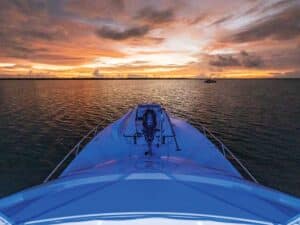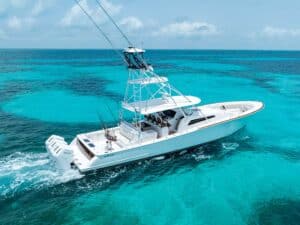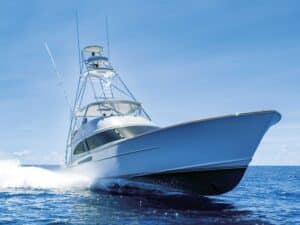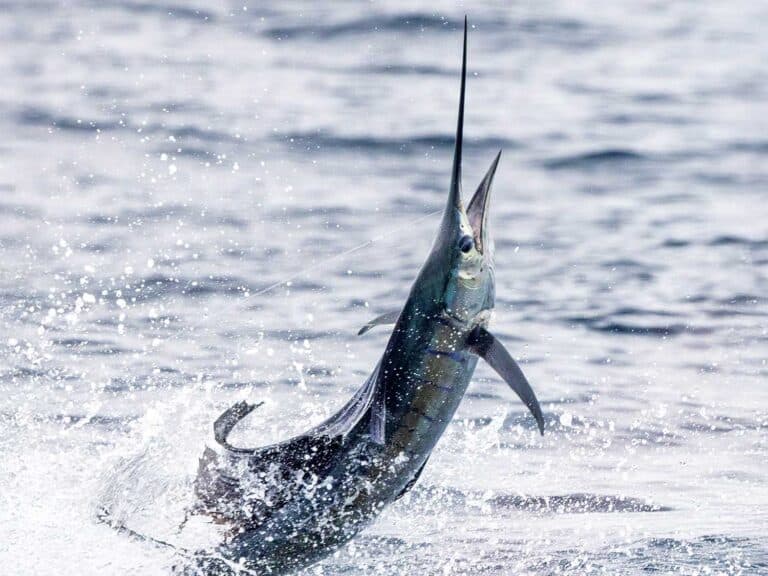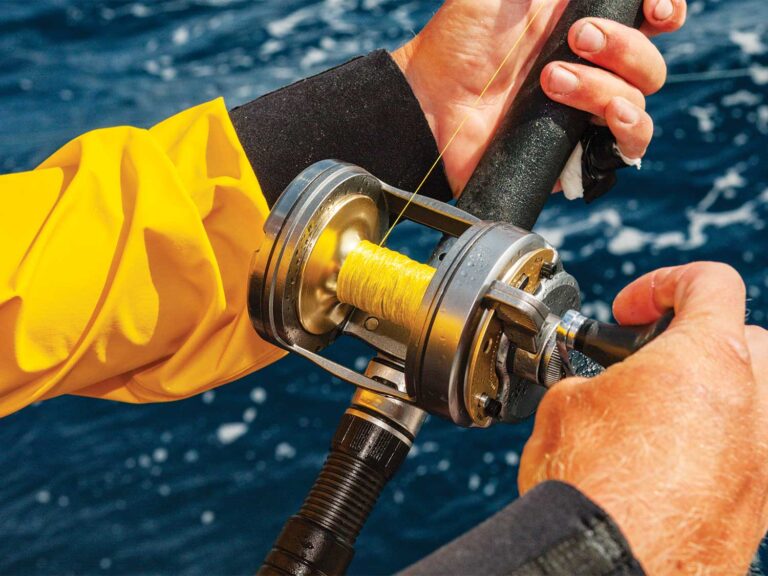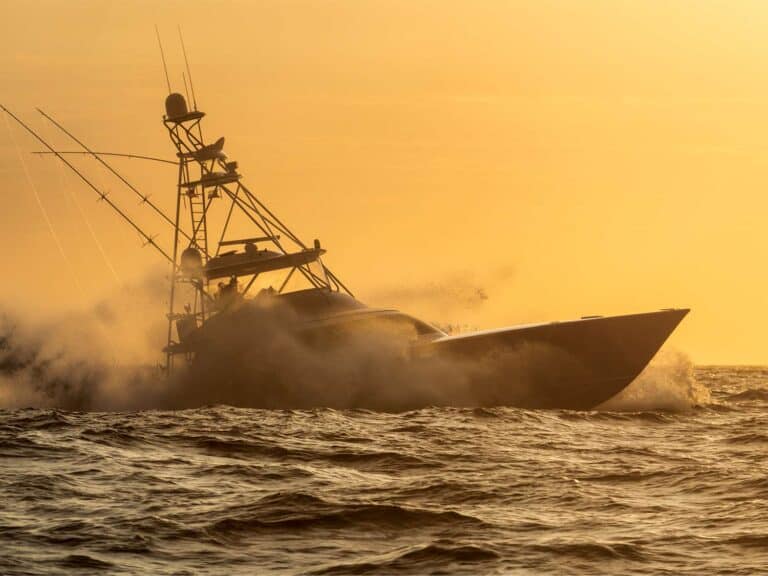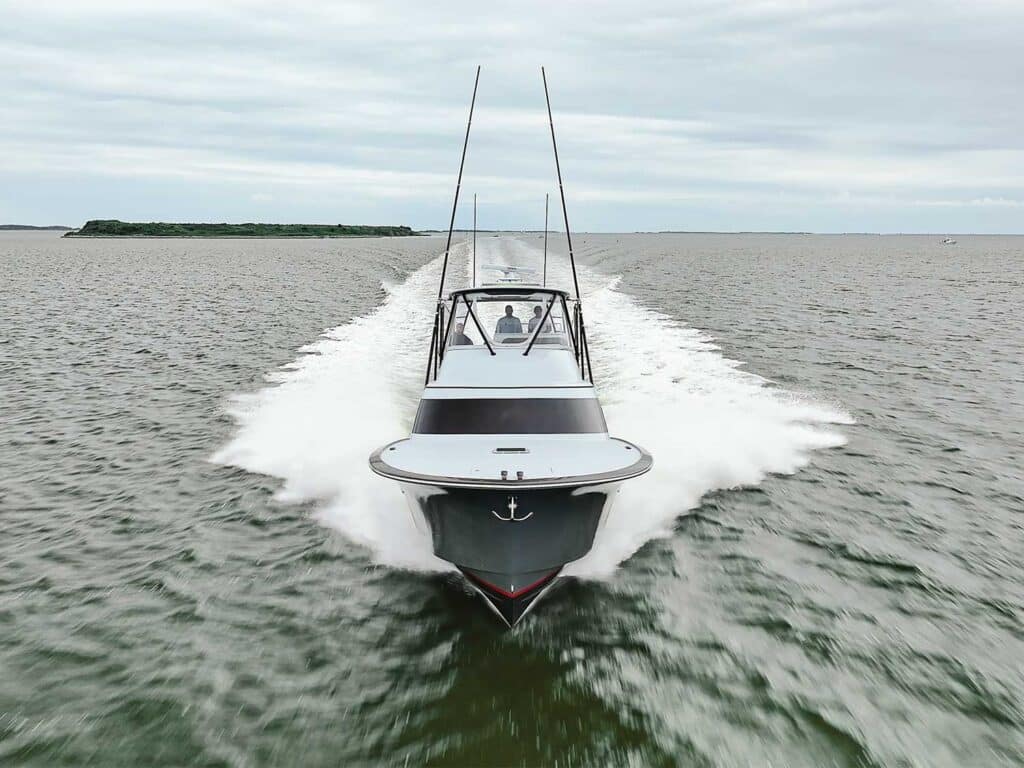
Subscribe to Marlin magazine and get a year of highly collectible, keepsake editions – plus access to the digital edition and archives. Sign up for the free Marlin email newsletter.
From Cape Verde to Kona, the Bad Company fleet roams the planet in pursuit of world-class marlin. Supported by two motherships, the sport-fishers in this renowned program visit some of the most remote blue waters on Earth. Owner Anthony Hsieh needed a boat that could handle 50-plus mile runs with greater range and comfort, yet remain nimble for serious sportfishing.
Working with Croswait Composites, the concept initially started as a 48-footer but evolved into a 50, thanks to advances in hull efficiency, weight distribution, and use of carbon fiber above the hull. Because the boat must be hoisted aboard a mothership, weight and height restrictions were critical—pushing Croswait to balance performance, size, and practicality without compromise. The result: a sleek, versatile express platform ready for global deployment.
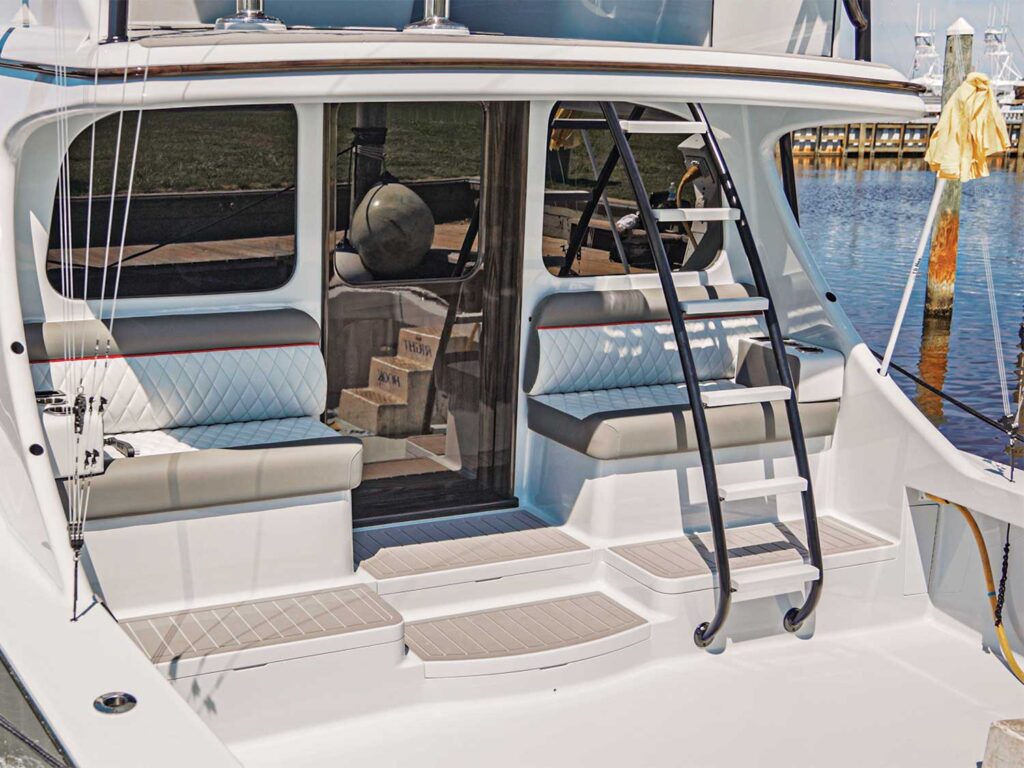
Cockpit and Mezzanine
The cockpit was designed with both live-baiting and general fishing in mind. A large transom livewell/fish box provides flexibility for bait or iced fish. Beneath the lazarette hatch, steering, pumps, and storage are neatly organized for fast service. The mezzanine combines comfort and function, with a high/low ice dump to port, bait and drink storage amidships, and starboard compartments for added utility. A lower step grants direct access to the fuel fills, plumbed with two-inch hoses for high-speed mothership transfers.
Comfortable seating accommodates up to four anglers, while discreet gaff storage is tucked under the gunwales. One standout feature is the custom-engineered starboard ladder angled to double as both ladder and staircase—allowing Hsieh to descend from the bridge without ever losing sight of the baits. At the heart of the cockpit sits a custom faux gray teak Scopinich fighting chair, built to Hsieh’s frame and style. Titanium cleats, custom-made for strength and corrosion resistance, add a refined touch.
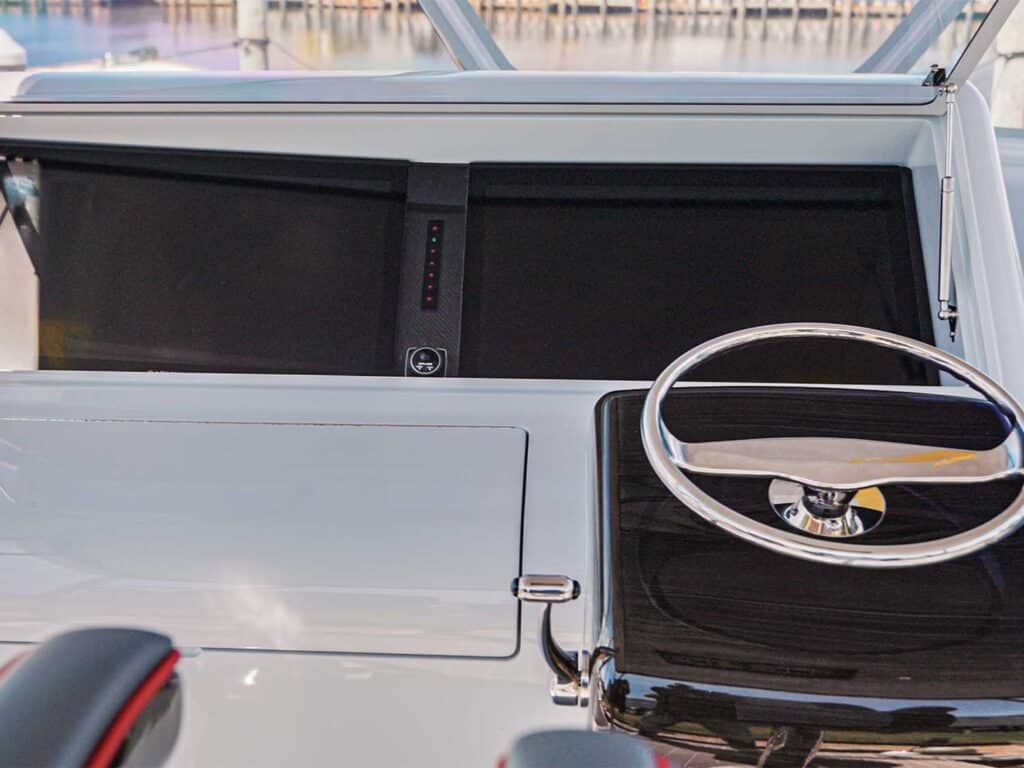
Bridge
Simplicity and function define the bridge. The peninsula helm, positioned to port, houses twin 27-inch Garmin displays for navigation, sonar, and systems monitoring, with all other electronics placed within easy reach. A radiused access door to starboard opens to a crawl-in space, providing both storage and service access to wiring and systems. Forward, a two-person bench seat hides storage, while a versatile seat to starboard can face forward or aft toward the cockpit.
Other thoughtful touches include a five-gallon bucket trash can under its own hatch, faux gray helm chairs for the captain and observer, and overhead Miya-Epoch US-9 teaser reels. The hardtop was engineered for mothership travel: secured by a few Allen bolts and a single Deutsch plug, it can be detached in minutes without sacrificing integrity.

Interior and Layout
A centerline door leads to a salon that balances comfort and utility. To starboard, a U-shaped dinette surrounds a high/low table that converts to a berth. To port, a loveseat transforms into another bunk with a removable backrest. Storage is abundant, with more than 26 charging ports ensuring all gear and electronics stay powered.
The split galley spans both sides of the salon, with refrigerator/freezer drawers, a microwave, and ample pantry space. Carbon fiber countertops reinforce the black, gray, and red aesthetic that marks every Bad Company vessel.
Below, two full berths with privacy curtains line the companionway, each with storage beneath and overhead “attic” compartments that double as access to the brow. A cleverly hidden Simrad Omni transducer lies beneath the lift-up stairs for easy inspection. Forward to port, a hanging locker with rod storage maximizes space, while to starboard a day head adds convenience. At the bow, the main head features a large shower and carbon-fiber vanities, continuing the boat’s modern, performance-driven design language.
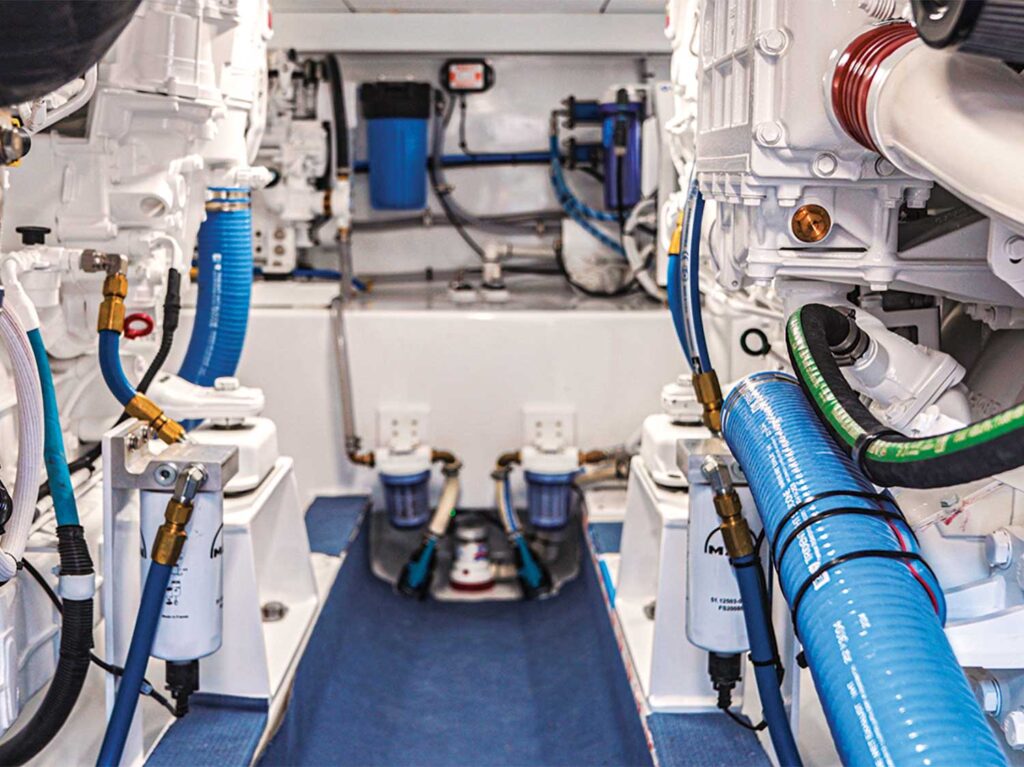
Engine Room
A centerline hatch on the mezzanine leads below to an engine room unusually spacious for a 50-footer. Twin MAN I6-850s dominate the space, mounted on lightweight yet exceptionally strong supports. Outboard, enclosed battery boxes with integrated breakers and neatly routed wiring emphasize both serviceability and safety.
Forward against the bulkhead, a sea chest doubles as a shelf, supporting the watermaker and generator while offering internal access for maintenance. The layout reflects the same thoughtful balance of efficiency and accessibility that defines the rest of the boat.
Performance
Sea trials proved the Croswait 50 to be remarkably quiet and vibration-free. At cruise, she runs 30–31 knots at 1,925 RPM and 76 percent load, burning just 56 gallons per hour. Wide open, she reaches an impressive 38 knots.
Her maneuverability is equally notable. Backing down at 7–8 knots or spinning on a marlin without engaging the thruster, she responds instantly—an asset when chasing hot fish. At 6 knots, the trolling wake lays out clean, maximizing spread effectiveness with Gemlux carbon-fiber outriggers.
Next stop for the new build is an 8,000-mile journey to Cape Town, where she’ll join the BCS 175 mothership. For Hsieh, Croswait, and the Bad Company crew, this 50-footer is the beginning of another bold chapter in one of sportfishing’s most ambitious programs.
Croswait 50 Specs
- LOA: 50’
- Beam: 16’
- Draft: 3’10”
- Dispel.: 33,000 lb.
- Fuel: 800 gal.
- Water: 140 gal.
- Power: Twin MAN I-6 850hp
- Gears/Ratio: Twin Disc MGX 5096A, 1:81:1 ratio
- Propellers: CJR 29/40 5 Blade
- Paint: Bad Company Grey
- Climate Control: (2) CTM CT-25H 25,000 BTU Units

